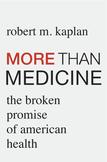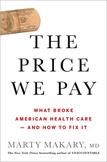Review: The unhealthy state of U.S. health care
Several years ago, I slipped in a hotel bathroom, hitting my head on the sink and then on the floor. My skull was fractured from the left parietal through the sagittal suture and on to the right parietal bone, with a subarachnoid hemorrhage and a small epidural hematoma under my left frontal region. I had a traumatic brain injury and my life was at risk.
Prior to this accident, I had never spent more than one night in a hospital. Having never been a real patient, this was a new experience, full of unknowns, as well as fear. Not only did I have my middle-of-the-night talks with God, in case I wouldn’t wake up in the morning, I felt tremendous concern for my spouse and two daughters, who were only 7 and 2 years old.
I worried, too, about the bills. Although as a tenured professor at a university I had health insurance, I had never used it before for anything so serious. Would it cover all the CT scans and MRIs? Would it pay for the couple of weeks in two different hospitals? Would it take care of my transport in an ambulance? Would my deductibles be astronomical? What if I needed neurosurgery? What would happen financially if I were disabled, or if lingering cognitive impairments prevented me from returning to work? I even anguished over possibly becoming addicted to my pain medication, an opioid.
Such matters regarding the costs of medicine are addressed in different, though complementary, ways in two books on broken U.S. health care: More Than Medicine:The Broken Promise of American Health, by Robert M. Kaplan, and The Price We Pay, by Marty Makary. Written accessibly in a journalistic key, the books are written by senior research scholars and professional health practitioners with distinguished careers. Kaplan, a psychologist, is Director of Research at the Stanford School of Medicine Clinical Excellence Research Center. Makary is a surgeon and professor of Health Policy at Johns Hopkins University.
About 1 in 5 Americans currently has unpaid medical debt. A study by the Kaiser Family Foundation reveals 70 percent of Americans have had to cut back on food, clothing or other basic needs to pay medical bills.
Predatory Practices
According to Makary, about 1 in 5 Americans currently has unpaid medical debt. He refers to a study by the Kaiser Family Foundation that reveals 70 percent of Americans have had to cut back on food, clothing or other basic needs to pay medical bills, with 58 percent taking an extra job or working additional hours and 41 percent borrowing money from friends or family to pay these bills. They are the casualties of the predatory and secretive “money games of medicine, loaded with middlemen, kickbacks and hidden costs.” Indeed, “gouging” is one of Makary’s most-used words to describe the “business model” that has come to dominate health care.
At one point he quotes the muckraking writer Upton Sinclair, an appropriate genre in which to consider Makary’s biting book, which opens with a health fair held at an urban African American church just 15 minutes from the U.S. Capitol building. Medical professionals there “weren’t serving; they were prospecting.” Through “predatory screening,” congregants were told that the blood flow in their legs is lower than in their arms, suggesting that something might be wrong and that further testing is necessary. According to Makary, “This test should not be performed unless a patient has serious symptoms, like crippling leg pain.”
Nevertheless, further tests then are “nudged” upon the patients, along with unnecessary ballooning, stenting and lasering of nonthreatening plaques in leg arteries—all of which costs these patients, Medicare, insurance and the rest of us while the doctors make “a lot of money” by “panning for gold” in this way. Disturbingly, Makary and his research team found 1,100 churches, synagogues and mosques where these vascular screening fairs are conducted, “despite a scientific consensus that people should not be screened this way for this disease.” Makary reflects, “The idea of the medical industry intruding on Sunday worship brought to mind the biblical account of Jesus throwing the merchants out of the temple.”
Similarly, Makary scrutinizes the cost of a heart bypass operation. Hospitals rarely, if ever, give a price quote in advance. In addition, insurance companies compete and negotiate discounts. In a study conducted by the University of Iowa, the average price was $151,271. The range was from $44,000 to $448,000, and there was no correlation between price and quality. Another analysis revealed that markups can be as much as 23 times higher than what is paid by Medicare. One president of a large insurance company, Dr. René Lerer, admits, “Insurers fight for a bigger discount every time they renew a contract with a hospital. Then hospitals go around and inflate their prices. It’s a game.” Indeed, hospitals use software called the “chargemaster” that automatically inflates prices toward a desired profit margin. While many say this is needed to compensate for their charity care, Makary counters that the data fails to support such an assertion.
Such markups are mirrored in a chapter about being “taken for a ride” in ambulances and helicopters. The price tag for the latter, often appearing as a “surprise bill” to the patient, is simply shocking. Here Makary notes that three companies now own 75 percent of these helicopters, with “wealthy business people” taking advantage of Americans “when they are most vulnerable.” He also devotes attention to other examples of such gouging, including unnecessary C-sections and Mohs surgeries for skin cancer. These “carrots” in the operating room tempt the medical professional to “get a bigger paycheck whether the extra acts are necessary or not.”
For those who cannot afford such hyperinflated prices, lawsuits and garnished wages are often in store. Particularly troubling was Carlsbad Medical Center in New Mexico, which one of the town’s court clerks said accounted for “like 95 percent of the lawsuits” there. Indeed, as Makary and his research team discovered, it had successfully sued and garnished the wages of 1 in 5 people in that small town—and they subsequently found, disturbingly, “that Carlsbad Medical Center was not alone.” Indeed, a similar pattern was found at 119 other hospitals operated by Community Health Systems, of which Carlsbad Medical Center is a part, in 20 states.
Thirty-seven percent of hospitals in the U.S. filed over 20,000 lawsuits in 2017 alone. It is especially unsettling that nonprofit hospitals were more likely to sue, and even faith-based hospitals are implicated. One Catholic hospital executive said, “We don’t sue patients” and “We forgive patients who can’t pay.” Markary’s investigation of the court records sadly showed otherwise.
Many hospitals use software called the “chargemaster” that automatically inflates prices toward a desired profit margin. While many say this is needed to compensate for their charity care, Makary counters that the data fails to support such an assertion.
‘Find It and Fix It’
Makary rightly names these and some other medical practices as “social injustice,” the result of the predominant business-centered approach. For his part, Kaplan is critical of a “cure narrative” that has captured American health care. Specifically, he focuses on how much health care consumes of the U.S. gross domestic product ($3.2 trillion, or 18 percent of the G.D.P. in 2017), in particular because of “the most expensive variety of that care: biomedicine.” But are these monetary investments producing better health outcomes? He thinks not.
Americans “have shorter life expectancies and higher infant mortality rates than the people of most other developed nations, and the gaps are widening.” U.S. obesity and homicide rates are higher than in the United Kingdom, Canada, France and Germany. The life expectancy of men in the United States is 75.65 years, which is last among 17 peer nations, and American women’s life expectancy is 80.78 years, which ranks in 16th place. Kaplan asks “what can be done to make up these gaps”—more colonoscopies and mammograms or exercise and weight loss? “The best data show that improving on social and behavioral risk factors is more worthwhile than investing in more medicine.”
For Kaplan, the main problem is that in the United States, attention is diverted from studying and addressing the numerous social and behavioral determinants for health and health problems, even though health determinants like violence, poverty, racism, workplace policy and stress, and poor education are viewed as crucial. Medicine does not address these problems. On this point, Makary agrees, recommending that medical providers seek the best health outcomes by understanding their patients’ social and economic realities. He highlights Iora Health, based in Boston, as an example of relationship-based, patient-centered medical practice.
U.S. universities, however, are perpetuating the problem, as they have become “research-intensive institutions heavily focused on biomedicine,” receiving large sums of money from the federal government—from the National Institutes of Health, for example, the largest funder of biomedical research. Too much money is devoted to research on Alzheimer’s disease, cancer, genomics and the like, but very little is targeted at the social, behavioral and environmental determinants that actually account for most premature deaths in the United States. Indeed, Kaplan offers example after example of the diminishing returns on the nearly $450 billion invested in U.S. scientific research annually.
From the Human Genome Project, which was completed nearly 20 years ago, to the latest genetics research, the payoff for this moonshot investment has been disappointing. Indeed, “almost none of the promise of the genomics revolution—gene therapy, detection of genetic precursors to disease, precision medicine—has been realized.” Very few diseases are associated with single-gene defects, and most chronic illnesses have hundreds, even thousands, of genetic variants and interactions. What instead is needed is “to better understand the complex relationships within the human body and between individuals and their social and physical worlds.”
For Kaplan, the main problem is that in the United States, attention is diverted from studying and addressing the numerous social and behavioral determinants for health and health problems, even though health determinants like violence, poverty, racism, workplace policy and stress, and poor education are viewed as crucial.
‘Cure Narratives’
Kaplan highlights the confession of Thomas Insel, who headed the National Institute of Mental Health and had downplayed behavioral research: “I spent 13 years at NIMH really pushing on the neuroscience and genetics of mental disorders, and when I look back on that I realize that…I succeeded at getting lots of really cool papers published by cool scientist at fairly large costs—I think $20 billion—I don’t think we moved the needle in reducing suicide, reducing hospitalizations, improving recovery for the tens of millions of people who have mental illness…. I hold myself accountable for that.”
Kaplan attributes this problematic “cure narrative” to “a fundamentally mistaken, mechanistic view of the human that diverts attention from the kinds of research and intervention that would be most useful in improving Americans’ health.” Biomedicine, he regrets, views people “like auto garages treat cars”—a “find it and fix it” philosophy that, while it is effective for some health problems, does not work for most. The money spent on genomics, with its assumption of biological determinism (i.e., genes determine health), reflects this view.
Both Kaplan and Makary are critical of over-testing, over-treating and over-prescribing, all of which are costly to Americans. Both, too, devote attention to the opioid crisis, which they agree is uniquely an American problem (one in 16 Americans becomes a chronic user). With 15,000 deaths from overdoses involving prescription opioids in 2015, it is the leading cause of death among Americans under the age of 50. Makary reports that 4.5 billion meds were prescribed in the U.S. in 2018 and notes that this contributes to the rising costs of insurance premiums. Echoing Makary’s criticism of the business-centered approach to health care, Kaplan adds that the drug industry spends “billions of dollars tweaking older, effective drugs in order to re-release them before patent monopolies run out.”
Profit over patients? Both authors show that this seems to be the case in many ways, and they both call for a more patient-centered approach to health care.
Profit over patients? Both authors show that this seems to be the case in many ways, and they both call for a more patient-centered approach to health care. Kaplan writes of “the power of patient history” in helping to take social factors seriously and urges better collaboration and communication among health care professionals, patients and families to counter doctors’ tendency to diagnose with a mechanistic approach.
While each writer mentions that health care professionals are well-intended or that the exorbitant costs to Americans pocketbooks and lives are “unintended casualties,” one might wonder, especially since in the Catholic moral tradition such casualties ought not be the means to an end, even if the end is a good one. The very recent prosecution of a top pharmaceutical executive, John Kapoor, and four other former executives of the company Insys Therapeutics, accused of bribing doctors to prescribe the highly addictive fentanyl spray Subsys, raises significant doubts for me about the appropriateness of that word “unintended.”
Both authors bring to our attention many more moral problems than have traditionally been evaluated in Catholic bioethics. While the Catholic Health Association and some theological ethicists like Lisa Sowle Cahill at Boston College have done so, integrating Catholic social teaching and health care ethics is still just beginning. The recent book, Catholic Bioethics and Social Justice: The Praxis of US Health Care in a Globalized World, edited by M. Therese Lysaught and Michael McCarthy, contains many chapters that point the way forward for engaging the kinds of questions raised by Kaplan and Makary.
This article also appeared in print, under the headline “Unhealthy Care,” in the June 10, 2019, issue.













